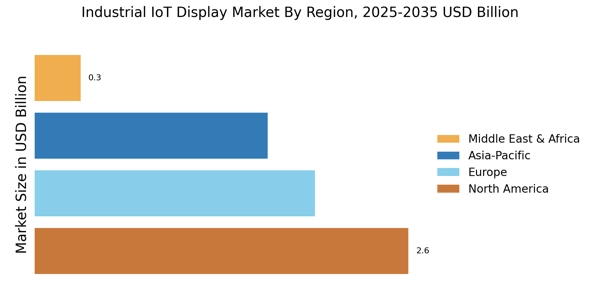Advancements in Display Technologies
Technological advancements in display technologies are significantly influencing the Industrial IoT Display Market. Innovations such as OLED and microLED displays offer enhanced resolution, energy efficiency, and durability, making them increasingly attractive for industrial applications. These advanced displays can withstand harsh environments, which is crucial for sectors like manufacturing and energy. Furthermore, the integration of touch capabilities and interactive features allows for more intuitive user interfaces, facilitating better user engagement. As industries continue to adopt these cutting-edge technologies, the market is expected to witness a substantial increase in demand, with projections indicating a growth rate of around 12% annually over the next few years.
Growing Emphasis on Safety and Compliance
Safety and compliance regulations are increasingly shaping the Industrial IoT Display Market. Industries are mandated to adhere to stringent safety standards, necessitating the use of displays that can effectively communicate critical information to operators. These displays are vital for real-time monitoring of safety protocols and compliance measures, ensuring that workers are informed of potential hazards. The market is likely to expand as companies invest in advanced display solutions that enhance safety and compliance. Recent data indicates that industries prioritizing safety measures are likely to see a reduction in workplace incidents by up to 30%, further underscoring the role of displays in promoting a safer working environment.
Rising Demand for Real-Time Data Visualization
The Industrial IoT Display Market is experiencing a notable surge in demand for real-time data visualization solutions. Industries are increasingly recognizing the value of immediate access to operational data, which enhances decision-making processes. This trend is particularly evident in sectors such as manufacturing and logistics, where timely insights can lead to improved efficiency and reduced downtime. According to recent estimates, the market for real-time data visualization tools is projected to grow at a compound annual growth rate of approximately 15% over the next five years. This growth is driven by the need for businesses to monitor performance metrics continuously and respond swiftly to changing conditions, thereby solidifying the role of displays in the Industrial IoT ecosystem.
Increased Focus on Automation and Smart Manufacturing
The Industrial IoT Display Market is being propelled by an increased focus on automation and smart manufacturing practices. As industries strive to enhance productivity and reduce operational costs, the integration of IoT devices and displays becomes essential. These displays serve as critical interfaces for monitoring automated processes, providing operators with vital information at a glance. The trend towards smart factories is expected to drive the market, with estimates suggesting that the adoption of IoT technologies in manufacturing could reach 70% by 2027. This shift not only enhances operational efficiency but also fosters a culture of continuous improvement, further solidifying the importance of displays in the Industrial IoT landscape.
Integration of Artificial Intelligence and Machine Learning
The integration of artificial intelligence (AI) and machine learning (ML) technologies is emerging as a transformative driver in the Industrial IoT Display Market. These technologies enable displays to provide predictive analytics and actionable insights, enhancing operational efficiency. By analyzing vast amounts of data, AI and ML can identify patterns and trends, allowing for proactive decision-making. This capability is particularly beneficial in sectors such as manufacturing and supply chain management, where timely interventions can prevent costly disruptions. The market for AI-driven display solutions is anticipated to grow significantly, with projections indicating a potential increase of 20% in adoption rates over the next few years, reflecting the growing reliance on intelligent systems in industrial settings.

















Leave a Comment